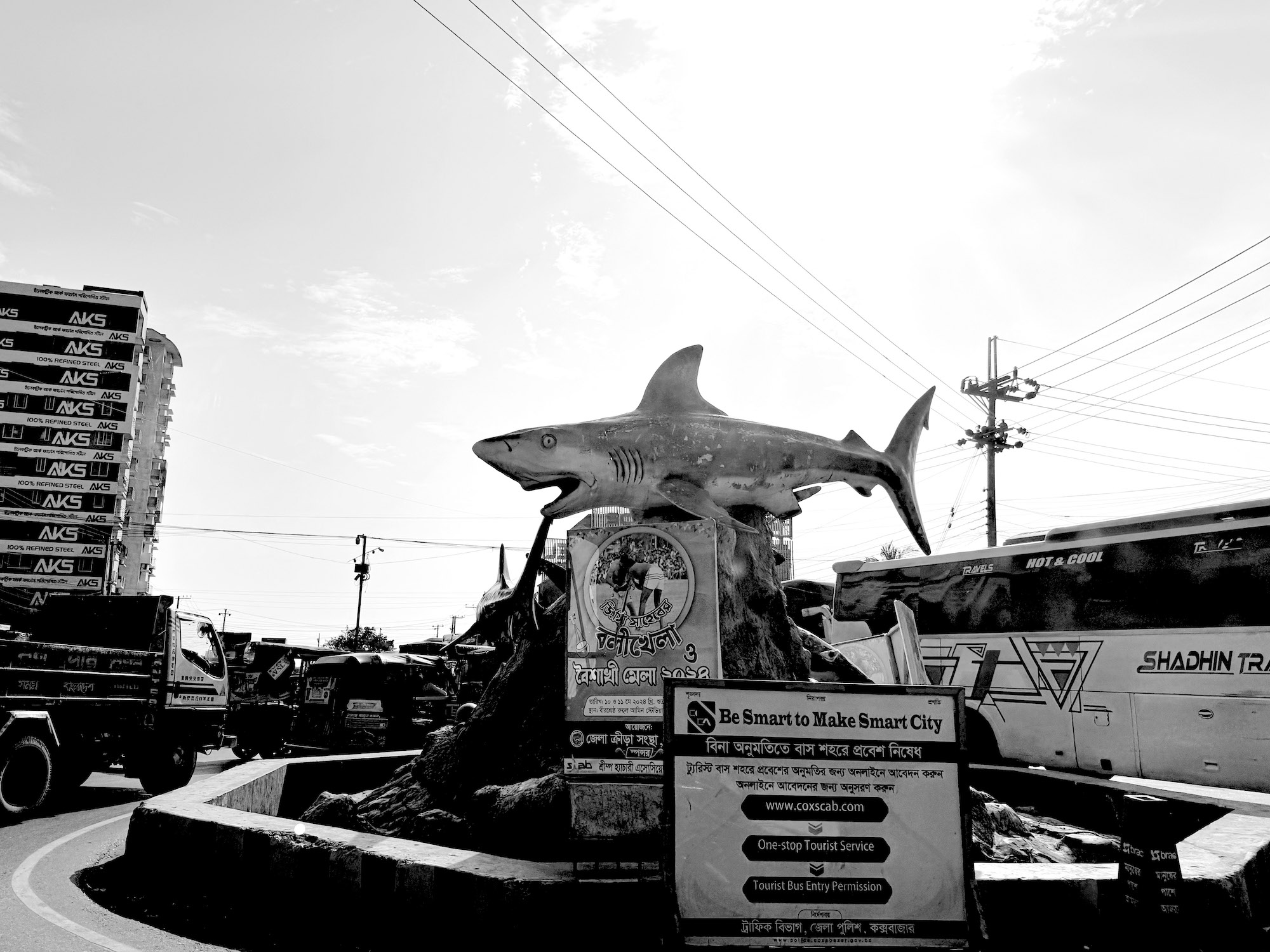Dolphin Square

Image courtesy of the author
The CASE FILE series — to which SEMIOVOX has invited our semiotician colleagues from around the world to contribute — shares stories of things we were amazed and amused to learn, whether or not they proved useful to the client.
A few months ago, I found myself conducting semiotics fieldwork across Bangladesh. At some point, my journey took me through various districts in the southern part of the country, always starting in the lively hub of the city Cox’s Bazar. Each day, without fail, I passed by a peculiar junction that always caught my eye.
Right in the middle of this junction stood a massive sculpture — undeniably a group of sharks. You’d think I’d get used to it after a while, but it surprised me every single time. The funny part? Everyone — absolutely everyone — referred to it as “Dolphin Square.” When I first heard this, I was convinced that Nasir, my interpreter, was joking. I mean, come on, those are definitely sharks! But he was completely serious. “Lucia, this is Dolphin Square,” he insisted.
Naturally, my curiosity was piqued. This odd naming turned into a fascinating semiotic treasure hunt. The area had once been known as “Kalatoli Square,” but somewhere along the way, before COVID, it morphed into “Dolphin Square” — despite the obvious shark sculptures. Cox’s Bazar Beach, interestingly enough, has neither sharks nor dolphins.
What fascinated me was how the locals had reimagined the intimidating shark symbol with a more amiable twist, thinking, “Let’s make this junction friendlier.” As a major tourist destination, Cox’s Bazar seemed keen to distance itself from the negative connotations associated with sharks. Thus, “Dolphin Square” emerged, an informal yet impactful rebranding that allowed the community to project positive traits like friendliness and playfulness, despite the actual presence of shark sculptures. It was a brilliant example of a community reshaping its identity and future through a simple shift in narrative. They crafted a new story, highlighting the warm, inviting image of dolphins over the potentially frightening perception of sharks. This was for me cultural adaptation at its finest.
As my time in Bangladesh drew to a close, I reflected on the intriguing meanings and contradictions I had encountered throughout the country. Instances like the shark-dolphin junction didn’t make it into any official reports, though they were certainly memorable enough to fill a book! What resonated with me about Dolphin Square was the powerful reminder of how the stories we tell, the names we choose, and the symbols we informally adopt can profoundly shape collective realities. That’s one of the wonders of semiotics. You never know where your next moment of inspiration will come from. Experiences like these rekindle my passion for the field, revealing hidden layers of meaning in the most unexpected places.
But there’s more — now there are discussions about replacing the shark sculptures with a statue of Sheikh Mujibur Rahman, the nation’s founding father. A semiotic rollercoaster, given the latest events in the country…
CASE FILE: Sónia Marques (Portugal) on BIRTHDAY CAKE | Malcolm Evans (Wales) on PET FOOD | Charles Leech (Canada) on HAGIOGRAPHY | Becks Collins (England) on LUXURY WATER | Alfredo Troncoso (Mexico) on LESS IS MORE | Stefania Gogna (Italy) on POST-ANGEL | Mariane Cara (Brazil) on MOTHER-PACKS | Whitney Dunlap-Fowler (USA) on WHERE THE BOYS ARE | Antje Weißenborn (Germany) on KITSCH | Chirag Mediratta (India) on “I WATCH, THEREFORE I AM” | Eugene Gorny (Thailand) on UNDEAD LUXURY | Adelina Vaca (Mexico) on CUBAN WAYS OF SEEING | Lucia Laurent-Neva (England) on DOLPHIN SQUARE | William Liu (China) on SCENT FANTASY | Clio Meurer (Brazil) on CHOCOLATE IDEOLOGY | Samuel Grange (France) on SWAZILAND CONDOMS | Serdar Paktin (Turkey/England) on KÜTUR KÜTUR | Ximena Tobi (Argentina) on SLUM PANDEMIC | Maciej Biedziński (Poland) on YOUTH LEISURE | Josh Glenn (USA) on THE AMERICAN SPIRIT | Martha Arango (Sweden) on M | Chris Arning (England) on X | Peter Glassen (Sweden) on WHEN SHABBY ISN’T CHIC | Joël Lim Du Bois (Malaysia) on RECONSTRUCTION SET | Ramona Lyons (USA) on THE FALL.
Also see these international semio series: COVID CODES | SEMIO OBJECTS | MAKING SENSE | COLOR CODEX | DECODER | CASE FILE

